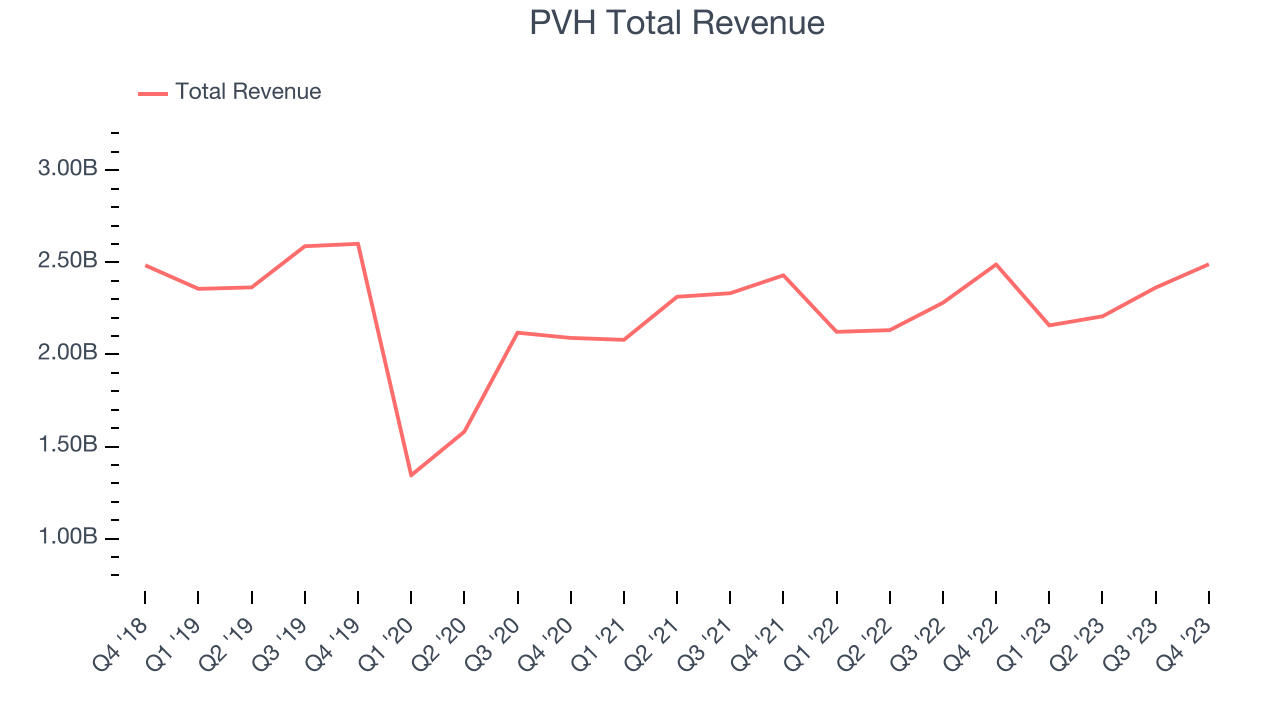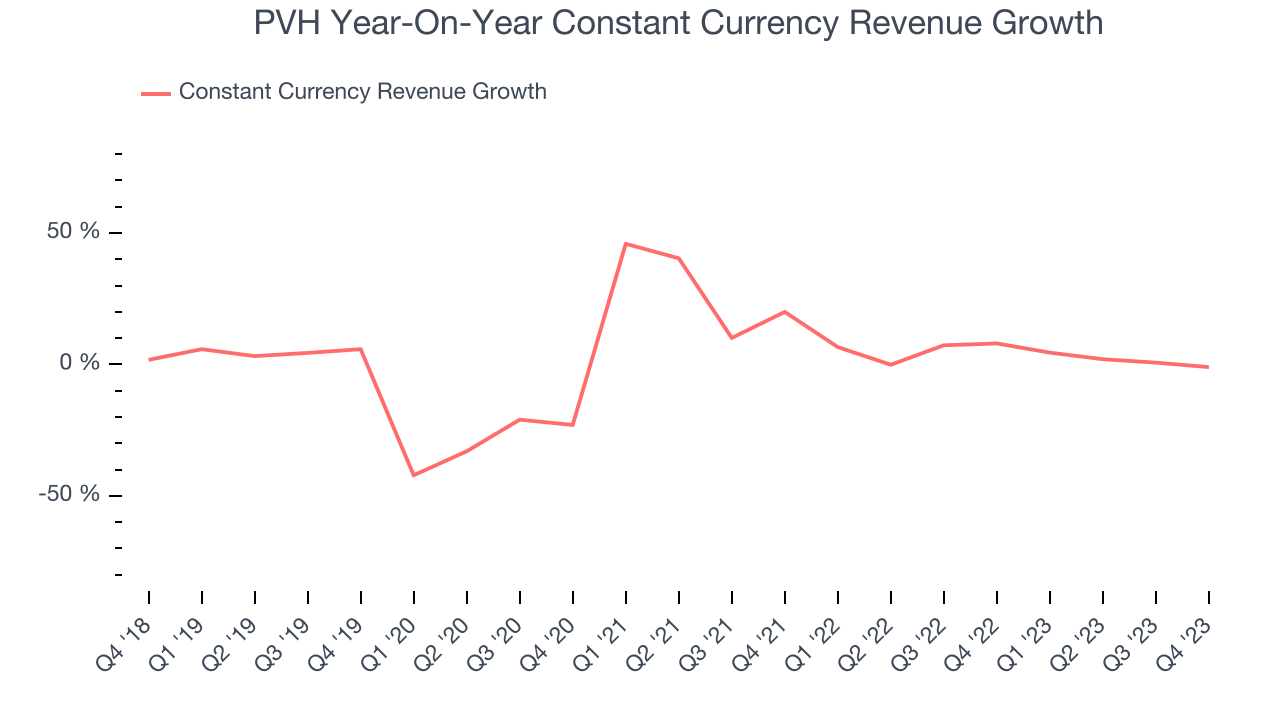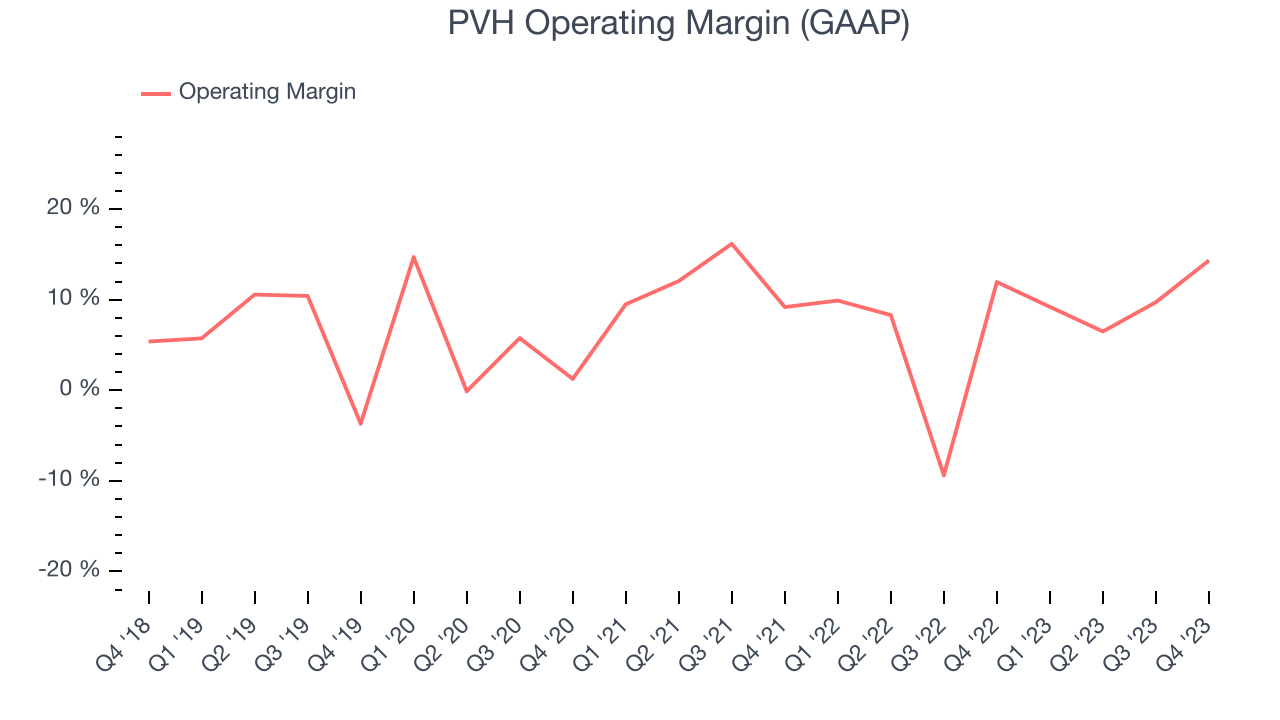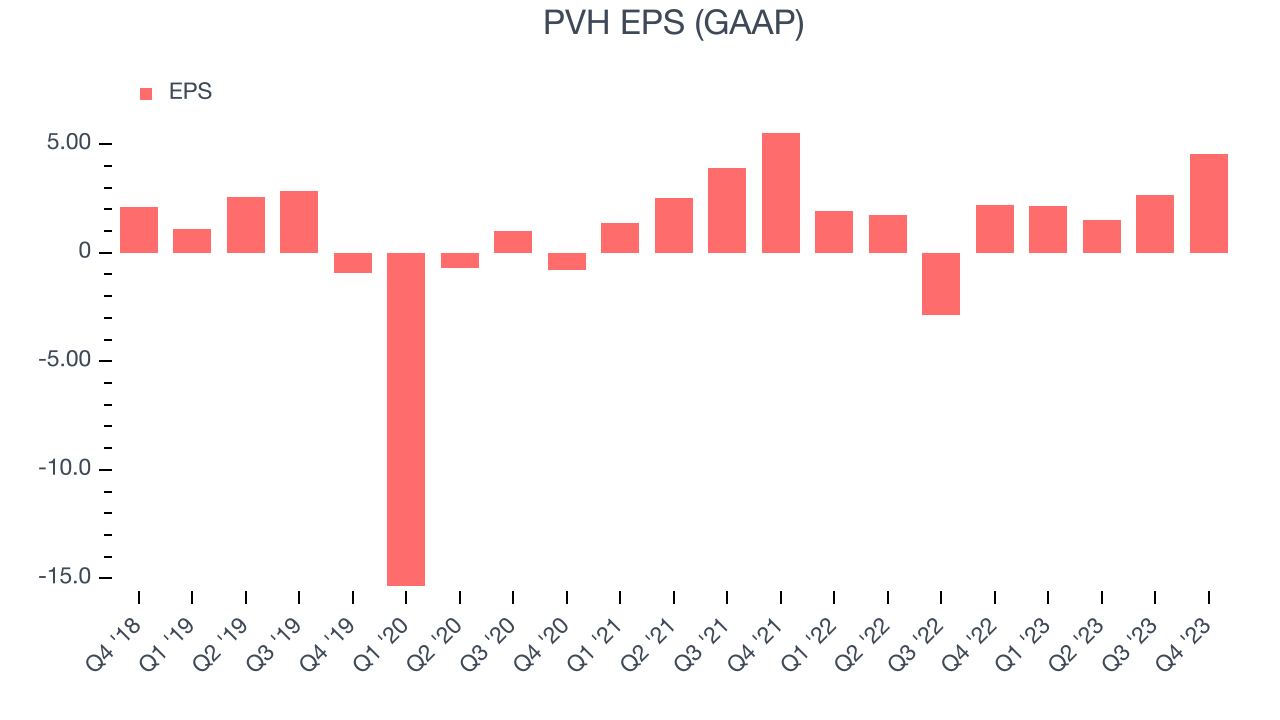Fashion conglomerate PVH (NYSE:PVH) announced better-than-expected results in Q4 CY2023, with revenue flat year on year at $2.49 billion. It made a non-GAAP profit of $3.72 per share, improving from its profit of $2.38 per share in the same quarter last year.
PVH (PVH) Q4 CY2023 Highlights:
- Revenue: $2.49 billion vs analyst estimates of $2.42 billion (2.9% beat)
- EPS (non-GAAP): $3.72 vs analyst estimates of $3.52 (5.7% beat)
- Full year 2024 EPS (non-GAAP) guidance: $10.88 vs analyst estimates of $12.04 (9,7% miss)
- Gross Margin (GAAP): 60.3%, up from 55.9% in the same quarter last year
- Market Capitalization: $8.39 billion
Founded in 1881 by a husband and wife duo, PVH (NYSE:PVH) is a global fashion conglomerate with iconic brands like Calvin Klein and Tommy Hilfiger.
PVH is headquartered in New York City and has transformed into one of the largest apparel companies in the world. Its portfolio also includes Van Heusen, IZOD, ARROW, and Warner’s; each holds a unique position in its respective market, catering to diverse consumer tastes and preferences.
Calvin Klein and Tommy Hilfiger, the flagship brands under PVH's umbrella, embody the classic American style and have a significant global presence. Calvin Klein is known for its modern, sophisticated styles, while Tommy Hilfiger is popular for its stylish American designs. These brands have become cultural icons.
The company operates through a mix of direct-to-consumer channels, including branded retail stores and e-commerce platforms, and wholesale distribution through department stores and specialty retailers. This omnichannel approach enables PVH to reach a broad customer base.
PVH's global presence is marked by its operations in over 40 countries, allowing it to tap into various international markets. The company’s international strategy focuses on localizing products and marketing efforts to cater to regional tastes.
Apparel, Accessories and Luxury Goods
Within apparel and accessories, not only do styles change more frequently today than decades past as fads travel through social media and the internet but consumers are also shifting the way they buy their goods, favoring omnichannel and e-commerce experiences. Some apparel, accessories, and luxury goods companies have made concerted efforts to adapt while those who are slower to move may fall behind.
PVH’s primary competitors include LVMH Moët Hennessy Louis Vuitton (Euronext:MC), Kering (Euronext:KER), Ralph Lauren Corporation (NYSE: RL), VF Corp (NYSE: VFC), and Hanesbrands Inc. (NYSE:HBI).Sales Growth
Reviewing a company's long-term performance can reveal insights into its business quality. Any business can have short-term success, but a top-tier one sustains growth for years. PVH's revenue was flat over the last five years.  Within consumer discretionary, product cycles are short and revenue can be hit-driven due to rapidly changing trends. That's why we also follow short-term performance. Just like its five-year revenue trend, PVH's revenue over the last two years has been flat, suggesting the company is in a slump.
Within consumer discretionary, product cycles are short and revenue can be hit-driven due to rapidly changing trends. That's why we also follow short-term performance. Just like its five-year revenue trend, PVH's revenue over the last two years has been flat, suggesting the company is in a slump.
PVH also reports sales performance excluding currency movements, which are outside the company’s control and not indicative of demand. Over the last two years, its constant currency sales averaged 3.5% year-on-year growth. Because this number is higher than its revenue growth during the same period, we can see that foreign exchange rates have been a headwind for PVH. 
This quarter, PVH's $2.49 billion of revenue was flat year on year but beat Wall Street's estimates by 2.9%. Looking ahead, Wall Street expects revenue to decline 2.1% over the next 12 months, a deceleration from this quarter.
Operating Margin
Operating margin is an important measure of profitability. It’s the portion of revenue left after accounting for all core expenses–everything from the cost of goods sold to advertising and wages. Operating margin is also useful for comparing profitability across companies with different levels of debt and tax rates because it excludes interest and taxes.
PVH was profitable over the last two years but held back by its large expense base. It's demonstrated mediocre profitability for a consumer discretionary business, producing an average operating margin of 7.7%.
In Q4, PVH generated an operating profit margin of 14.3%, up 2.4 percentage points year on year.
Over the next 12 months, Wall Street expects PVH to maintain its LTM operating margin of 10.1%.EPS
Analyzing long-term revenue trends tells us about a company's historical growth, but the long-term change in its earnings per share (EPS) points to the profitability and efficiency of that growth–for example, a company could inflate its sales through excessive spending on advertising and promotions.

Over the last five years, PVH's EPS grew 12.4%, translating into a weak 2.4% compounded annual growth rate. This performance, however, is materially higher than its flat revenue over the same period. There are a few reasons for this, and understanding why can shed light on its fundamentals. PVH's operating margin has expanded 9 percentage points over the last five years while its share count has shrunk 21.6%. Improving profitability and share buybacks are positive signs as they juice EPS growth relative to revenue growth.
In Q4, PVH reported EPS at $4.55, up from $2.18 in the same quarter a year ago. Its $3.72 of non-GAAP EPS beat expectations by 5.7% this quarter.
Return on Invested Capital (ROIC)
EPS and free cash flow tell us whether a company was profitable while growing revenue. But was it capital-efficient? Enter ROIC, a metric showing how much operating profit a company generates relative to how much money the business raised (debt and equity).
PVH's five-year average return on invested capital was 4.9%, somewhat low compared to the best consumer discretionary companies that pump out 25%+. Its returns suggest it historically did a subpar job investing in profitable business initiatives.
The trend in its ROIC, however, is often what surprises the market and drives the stock price. Unfortunately, PVH's ROIC over the last five years averaged 1.1 percentage point decreases each year. In conjunction with its already low returns, these declines suggest the company's profitable business opportunities are few and far between.
Key Takeaways from PVH's Q4 Results
We were impressed by how significantly PVH blew past analysts' constant currency revenue expectations this quarter. We were also excited its operating margin outperformed Wall Street's estimates. On the other hand, its full-year earnings forecast was underwhelming, and this is heavily pressuring the stock. Specifically, the stock is down 17.7% after reporting, trading at $115 per share.
Is Now The Time?
PVH may have had a favorable quarter with poor guidance, but investors should also consider its valuation and business qualities when assessing the investment opportunity.
We cheer for all companies serving consumers, but in the case of PVH, we'll be cheering from the sidelines. Its revenue has declined over the last five years, and analysts expect growth to deteriorate from here. On top of that, its relatively low ROIC suggests it has historically struggled to find compelling business opportunities, and its cash burn raises the question of whether it can sustainably maintain growth.
PVH's price-to-earnings ratio based on the next 12 months is 11.6x. While we've no doubt one can find things to like about PVH, we think there are better opportunities elsewhere in the market. We don't see many reasons to get involved at the moment.
Wall Street analysts covering the company had a one-year price target of $137.61 per share right before these results (compared to the current share price of $115).
To get the best start with StockStory, check out our most recent stock picks, and then sign up for our earnings alerts by adding companies to your watchlist here. We typically have the quarterly earnings results analyzed within seconds of the data being released, and especially for companies reporting pre-market, this often gives investors the chance to react to the results before the market has fully absorbed the information.
